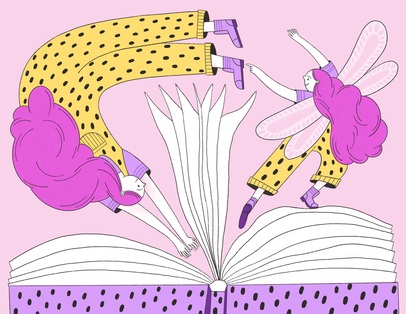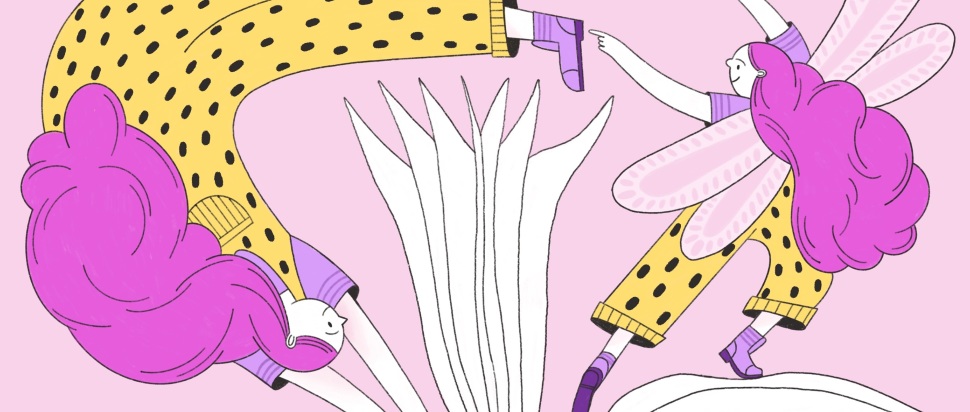On the magic of reading (and writing) children’s books
Why do we miss out on the magic of reading children's literature as adults? Nadine Aisha Jassat examines her own entanglement with children's literature as both author and avid reader
I first fell in love with books when I was a child. I would go to the library after school and read shelf to shelf, taking home books which were my plastic-covered, date-stamped treasures. They gave me a love of reading, and introduced me to one of my favourite feelings: being swept away into the magic of a story.
As a writer, I’ve come to look at what I do as a kind of magic, too, one I’m still learning to understand. How is it that I sit at a blank page, put my fingers to the keyboard or pen, and suddenly find myself in another world? How is it that the characters from my books who come from some unknown part of my mind feel so real, so much so that I sometimes think: "Ray from The Stories Grandma Forgot would love this", or, "I wish The Hidden Story of Estie Noor’s Aunt Ru was here to give me a hug"? I don’t underestimate my many hours of plotting, planning, craft and edits, but there’s no denying the magic. It’s there, too, when young readers tell me that my characters felt like friends, that even after they finished the book, they found themselves wanting to turn around and talk to them. The joy I experienced as a child has come full circle, and I have somehow managed to give this gift, this magic, to readers now.
Reading and writing books for children has taught me that they still speak to us as adults. They answer the questions and feelings we once had, and might still hold. They’re brilliant reads, too. Among middle-grade fiction (the term given broadly to books aimed at 9-12 year-olds), Sophie Anderson’s novel The House With Chicken Legs thrilled me with its plot, pacing and world building, but it also spoke to my grief. The picture book Namaste is A Greeting by Suma Subramaniam and Sandhya Prabhat, who also illustrates my novels, moved me in the same way adult poetry does. Angie Thomas’ young adult novel The Hate U Give is a masterpiece: when I find out a friend hasn’t read it, it’s all I can do to not put a copy in their hands then and there. Dean Atta’s young adult verse-novel The Black Flamingo had me wishing I could time-travel – a bit of a recurring theme for me, given how Nyla understands her grandma’s Alzheimer’s in The Stories Grandma Forgot. I wanted to be able to give Atta’s novel back to my younger self: it was a book I needed then, and a book I met with joy and deep appreciation encountering it as an adult.
When writing my middle grade verse-novels, The Stories Grandma Forgot and The Hidden Story of Estie Noor, I’ve time-travelled to feelings held within me. I’ve spoken to past selves, and spun their wisdoms and their questions into something solid and glimmering, into words and story and gold. Through that process, my novels have given something back to me, and I hope to readers, too: whether it’s Nyla’s exploration of being mixed, Estie’s journey to finding her voice, or simply the pleasure of curling up with a book and feeling that, within its pages, you have found a friend.
There has been much discussion in recent years about the smaller presence of children’s books in review spaces, award categories, or coverage more broadly. But isn’t their contribution to literature just as valid as any other? Didn’t they make this writer a reader, and so many others? Is it not a phenomenal skill – to take complex themes, or create new worlds – and make them accessible to young readers? The world of children’s literature is an open door for many to embrace, and we should all celebrate that. Feedback from adult readers of my novels echo the same sentiments I’ve discovered, the most frequent being that they ‘feel like a hug’, and that they spoke to themes important to readers’ lives – Alzheimer’s, voice, identity – or were simply really enjoyable ("I never guessed that plot twist!"). Children’s books should and must always centre and speak to children, but that doesn’t mean that older readers can’t enjoy them, too.
So many adults may think, perhaps automatically or simply out of habit: "I don’t read children’s books." And that’s okay – not everybody has to love every book, and life is too short to not read what you enjoy, to not embrace the books that you find magic in. But. If you have space on your shelf, or in your reader’s heart. If you have a spare afternoon, or a library card. I encourage you to explore the books making a new generation of readers, and find one that sparks your interest. It might just be magic, too.

Illustration: Lada Chizhova.
The Hidden Story of Estie Noor by Nadine Aisha Jassat with illustrations by Sandhya Prabhat is out with Hachette Children’s Group on 9 May
